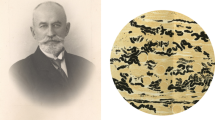Summary
Accumulations of silver and mercury can be visualized in tissue sections by a technique called autometallography or physical development. In order to make a histological differentiation between mercury and silver in tissue exposed to both metals, it is necessary to remove one of the metals while leaving the other untouched. The present paper describes a technique by which silver accumulations in histological sections can be removed by potassium cyanide, yet leaving mercury accumulations intact to be developed autometallographically.
Similar content being viewed by others
References
AASETH, J., OLSEN, A., HALSE, J. & HOVIG, T. (1981) Argyria-tissue deposition of silver as selenide.Scand. J. clin. Lab. Invest. 41 247–51.
DANSCHER, G. (1981a) Histochemical demonstration of heavy metals. A revised version of the sulphide silver method suitable for both light and electron microscopy.Histochemistry 71 1–16.
DANSCHER, G. (1981b) Light and electron microscopic localization of silver in biological tissue.Histochemistry 71 177–86.
DANSCHER, G. (1982) Exogenous selenium in the brain. A histochemical technique for light and electron microscopical localization of catalytic selenium bonds.Histochemistry 76 281–93.
DANSCHER, G. (1984) Autometallography.Histochemistry 81 331–5.
DANSCHER, G., HOWELL, G., PEREZ-CLAUSELL, J. & HERTEL, N. (1985) The dithizone, Timm's sulphide silver and the selenium methods demonstrate a chelatable pool of zinc in CNS.Histochemistry 83 419–22.
DANSCHER, G. & MØLLER-MADSEN, B. (1985) Silver amplification of mercury sulfide and selenide.J. Histochem. Cytochem. 33 219–28.
DANSCHER, G. & ZIMMER, J. (1978) An improved Timm sulphide silver method for light and electron microscopic localization of heavy metals in biological tissues.Histochemistry 55 27–40.
DEMPSEY, E. W. (1973) Neural and vascular ultrastructure of the area postrema of the rat.J. comp. Neurol. 150 177–200.
JAMES, T. H. (1939) The reduction of silver ions by hydroquinone.J. Am. Chem. Soc. 61 648–52.
JAMES, T. H. (1977)The Theory of the Photographic Process. New York: Macmillan.
LIESEGANG, R. (1928) Histologische Versilberung.Z. wiss. Mikrosk. 45 273–9.
RUNGBY, J., DANSCHER, G., MØLLER-MADSEN, B., RESKENIELSEN, E. & HANSEN, J. C. (1983) Localization of silver and mercury in human brain tissue.Neurosci. Letts., suppl. 14, 318.
SHIRABE, T. (1979) Identification of mercury in the brain of Minamata disease victims by electron microscopic X-ray microanalysis.Neurotoxicology 1 349.
TIMM, F. (1958) Zur Histochemie der Schwermetalle. Das Sulfid-Silber-Verfahren.Dtsch. Z. Gesamte Gerichtl. Med. 46 706–11.
TIMM, F. (1962) Der histochemische Nachweis der Sublimatvergiftung.Beitr. Gerichtl. Med. 21 195–7.
Author information
Authors and Affiliations
Rights and permissions
About this article
Cite this article
Danscher, G., Rungby, J. Differentiation of histochemically visualized mercury and silver. Histochem J 18, 109–114 (1986). https://doi.org/10.1007/BF01675364
Received:
Revised:
Issue Date:
DOI: https://doi.org/10.1007/BF01675364




